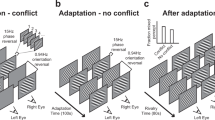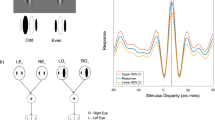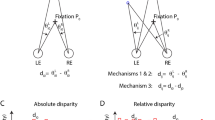Abstract
An impression of a surface seen through holes is created when one fuses dichoptic pairs of discs with one member of each pair black and the other white. This is referred to as the ‘sieve effect’. This stimulus contains no positional disparities. The impression of depth in the sieve effect is most evident when the size, contrast, and rim thickness of rivalrous patterns are such as to produce exclusive rivalry. I investigated how long it took for the sieve effect to recover from exclusive rivalry suppression. The magnitude of perceived depth in the effect was measured after exclusive rivalry suppression of one half-image of the sieve-effect stimulus. The results showed that the sieve effect takes approximately 630 ms to recover from exclusive rivalry suppression, compared with 200 ms for disparity-based stereopsis. Considered together with the previous report [Matsumiya and Howard: Invest. Ophthalmol. Visual Sci. 42 (2001) S403] that the sieve effect is positively correlated with the rate of exclusive rivalry, these findings suggest that the effect and exclusive rivalry are processed in the identical channel.
Similar content being viewed by others
References
B. Julesz and C. W. Tyler: Biol. Cybernetics 23 (1976) 25.
J. M. Wolfe: Psychol. Rev. 93 (1986) 269.
I. P. Howard: in Seeing in Depth, ed. I. P. Howard (I Pourteous, Toronto, 2002) Vol. 1, p. 304.
A. Treisman: Q. J. Exp. Psychol. 14 (1962) 23.
L. Kaufman: Am. J. Psychol. 77 (1964) 193.
K. N. Ogle and J. M. Wakefield: Vision Res. 7 (1967) 89.
V. S. Ramachandran and S. Sriram: Nature 237 (1972) 347.
B. Julesz and J. E. Miller: Perception 4 (1975) 125.
S. Shimojo and K. Nakayama: Vision Res. 30 (1990) 69.
R. Hayashi, T. Maeda, S. Shimojo and S. Tachi: Vision Res. 44 (2004) 2367.
R. A. Harrad, S. P. McKee, R. Blake and Y. Yang: Perception 23 (1994) 15.
I. P. Howard: Perception 24 (1995) 67.
H. von. Helmholtz: in Physiological Optics, ed. J. P. C. Southhall (Dover, New York, 1962) English translation from Handbuch der Physiologischen Optik (Voss, Hamburg, 1909) 3rd ed.
R. P. O'Shea and R. Blake: Percept. Psychophys. 42 (1987) 205.
R. Blake, R. P. O'Shea and T. J. Mueller: Visual Neurosci. 8 (1992) 469.
K. Matsumiya and I. P. Howard: Invest. Ophthalmol. Visual Sci. 42 (2001) S403.
J. J. Tsai and J. D. Victor: Vision Res. 40 (2000) 2265.
Author information
Authors and Affiliations
Corresponding author
Rights and permissions
About this article
Cite this article
Matsumiya, K. Influence of Exclusive Binocular Rivalry on Perceived Depth in the ‘Sieve Effect’. OPT REV 13, 39–45 (2006). https://doi.org/10.1007/s10043-006-0039-0
Received:
Accepted:
Issue Date:
DOI: https://doi.org/10.1007/s10043-006-0039-0




